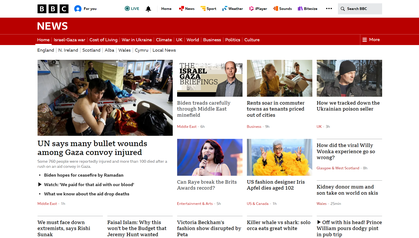Not known Incorrect Statements About Popular News
Not known Incorrect Statements About Popular News
Blog Article
An Unbiased View of Popular News
Table of ContentsThe Best Strategy To Use For Popular NewsPopular News for DummiesThe Ultimate Guide To Popular NewsExcitement About Popular News
Age is also an aspect in the means individuals check out the function of social media sites. Younger social networks news consumers are more likely to state it has impacted their knowing right. Regarding fifty percent of social media sites information customers ages 18 to 29 (48%) state news on social media makes them better educated, compared to 37% of those 30 to 49, 28% of those 50 to 64, and 27% of those 65 and older.Journalists consider news worths when establishing whether or not to cover an event or news. Perhaps the most crucial element of newsworthiness is whether or not the information item being connected impacts an information outlet's target market.
Proximity is essential. Journalists want things that affect their communities. Study on a state's new tax obligation code likely won't produce the exact same interest throughout state borders. Sometimes specialists can help center a bigger nationwide story that affects even more than simply a city or state. In these cases, it is crucial to be in search of chances where topic specialists can provide insight or where comparable tasks might be happening locally.
If you are releasing newsworthy study, loophole in MarComm prior to the article being published to make sure that the pitch can stress the newest element of the story: the publication of the research. Events and announcements that involve high-profile figures are more likely to generate media coverage. Sees from nationwide numbers usually call for months of prep work as a result of awaited community interest.
The Ultimate Guide To Popular News
Stories usually entail some type of conflict. Necessarily, these tales are often controversial to some degree. Thankfully, university staff and professors are generally perceived as neutral experts. We can aid alleviate potential reputational threat with these stories while additionally enhancing the chances of creating insurance coverage. While a lot of the above information values are intertwined, human interest tales usually stand apart.
Human rate of interest aspects can include news worth to other tales that could seem lacking in the various other values. The uniqueness or peculiarity of a circumstance can assist affect whether or not a news outlet is most likely to cover a story. While this is not an extensive listing, checking to see if your story or occasion has these qualities prior to contacting us will certainly assist you establish which elements hold the most information worth.

The Definitive Guide for Popular News
There is additionally considerable evidence that even more consumers can begin to spend for information in the futureif publishers can recognize them and offer them well. Half of those that do not pay for news actively choose information and resemble clients in various means. And almost 2 in 10 of those that don't register for news currently indicate they are inclined to start to pay in the future.
We then ask a collection of concerns to determine whether individuals spend for certain sorts of information sources (Popular News). We asked individuals to name the resources they utilize most oftenwhether they spend for them or nothow they use them, the specific things they take into consideration vital regarding them, and some related inquiries regarding the cost and value of that resource
People are attracted to information generally for two reasons over others: A desire to be informed residents (paper subscribers in specific are very motivated by this) and since the magazine they subscribe to excels at covering specific subjects concerning which those subscribers especially care. While there are a host of factors, the No.
Greater than 4 in 10 also point out the reality that loved ones register for the very same item (Popular News). Greater than a third of people say they initially subscribed in reaction to a price cut or promotion. In print, individuals also are relocated greatly to sign up for obtain discount coupons that conserve them money, something that has untapped ramifications visit homepage in electronic
Get This Report about Popular News
Concerning fifty percent are "information hunters," indicating they proactively seek information as opposed to mainly bumping into it in a much more easy means, though the information that nonpayers are looking for (in the meantime, a minimum of) is frequently regarding nationwide politics. Like clients, many of these people likewise obtain information numerous times a day, make use of the news in ways similar to clients, and are go to this site interested in similar topics, including international or global information.

Of those that do pay, 54 percent register for papers in print or electronically, which stands for 29 percent of Americans overall. Most of them buy a print publication along with their newspaper and spend for 2 to 4 news sources in total, some even much more. And while 53 percent are long-time customers (5+ years), more than a quarter (27 percent) have purchased their paper registration within the previous year.
Couple of print subscribers assume it most likely they will certainly switch to a digital-only membership in the future, and more than half of those that like electronic have actually never paid for a print version of the exact same source. Totally 75 percent of paper payers state they mostly checked out the paper in print, while 21 percent are mainly digital users, and 4 percent describe themselves as uniformly split.
Report this page